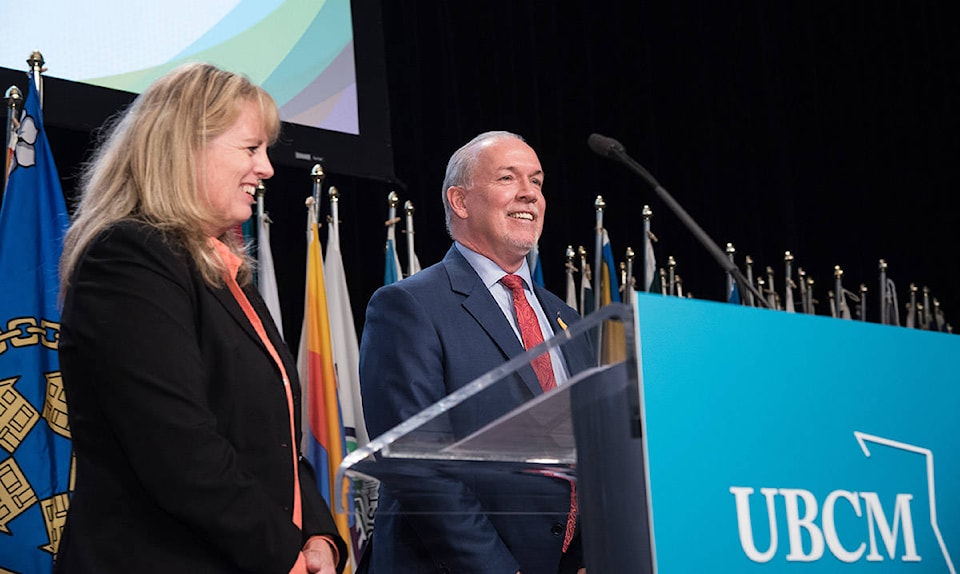Local politicians across the province recently got the opportunity to rub shoulders with their provincial counterparts at an annual conference to air out priorities and concerns to specific ministers and ministries.
A large contingent from the East Kootenay attended the Union of British Columbia Municipalities (UBCM) convention to make their cases for local issues and to vote on non-binding resolutions.
RDEK board chair Rob Gay says he, along with other regional municipal politicians, went to Vancouver to talk about issues ranging from highways to waterways in the Elk Valley to the urban wild land interface.
Gay said he also had a meeting with provincial RCMP brass to talk about staffing and equipment for the southeast corner of the province.
“They were concerned about staffing and I was surprised; I guess their vehicles aren’t in the best of shape so we said we’d go meet and bring these things up,” Gay said.
“…They had done a study and analysis and they said, ‘yeah, the southeast corner needs some additional members.’
“So they were definitely in agreement with that.”
Another meeting included the Ministry of Transportation to talk about a turnoff for Elko.
“It’s just, we feel, a very dangerous area there,” said Gay. “There’s no turning lane and now that we have our fire department there, it’s created a different situation. If a large firetruck needs to come out on the highway and make a left turn, it’s quite difficult.”
Another meeting included the Ministry of Forests, Lands, Natural Resources and Rural Development to talk about water tables and levels in Baynes Lake, Surveyors Lake and other water bodies in the South Country.
“The contention is that those pothole lakes are filled from some sinkholes along the Elk River, so when the Elko dam is full, these sinkholes are in a location where water goes into these sinkholes and flows downhill to the Baynes Lake country,” Gay said.
“Now [BC] Hydro has never really agreed with that theory; they don’t disagree, but what’s happened over time is that the river has changed course and now the water is no longer near these sinkholes and what the people in the South Country are saying is that the water table is lower.”
Another topic also included getting the ball rolling on an access management plan for the upper and lower Columbia Valley.
Agriculture was also another area of interest, as Gay said board directors wanted to stress the importance of agro-tourism as an additional means of revenue generation for local farmers.
The Agricultural Land Reserve (ALR) is comprised of two zones; zone one is primarily for farming purposes, while zone two still has a priority on farming, but allows for agro-tourism options such as hosting weddings, Gay said.
“That flexibility has been good for our ranchers and producers,” he added.
While UBCM is an opportunity for local politicians to meet with provincial cabinet ministers and ministry representatives, it’s also an opportunity to address policy initiatives through resolutions.
Over 160 resolutions were proposed, either endorsed or rejected, in non-binding votes from the floor, with topics ranging from interface wildfire prevention to Canada Goose population management to local government photo radar.
Gay pointed out local governments are grappling with pending legislation from the federal government surrounding the legalization of marijuana.
“The one really unknown for many of us…was around this marijuana legislation because it’s going to get rolled out and the Liberals and [Justin] Trudeau are not backing down at all and 2018 is not that far off. There were questions about that, and certainly more questions than answers,” Gay said.
Another issue involves paramedic staffing in rural areas and the response times for first responders. In rural parts of the province, volunteer firefighters are often doubling as first responders and are needing basic first aid training now in addition to their firefighting training.
Gay cites the example of responding to a car accident near a rural area like Jaffray.
“The rub in that is that in BC we have a rule that only the BC Ambulance [Service] can transport people,” Gay said. “In Jaffray, for example, they wait for Fernie or Cranbrook depending on what car is available to transport this person.
“It could be minus 20 and they’re in a car accident, they could be on the ground for 45 minutes/an hour before they get there. Where we got a warm vehicle, we got a couple people already there, sometimes, would it make sense to stick them in one of our vehicles or drive them to Fernie or meet them halfway?”
